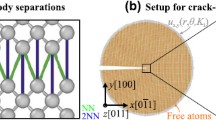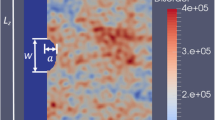Abstract
We study the behavior of brittle atomistic models in general dimensions under uniaxial tension and investigate the system for critical fracture loads. We rigorously prove that in the discrete-to-continuum limit the minimal energy satisfies a particular cleavage law with quadratic response to small boundary displacements followed by a sharp constant cut-off beyond some critical value. Moreover, we show that the minimal energy is attained by homogeneous elastic configurations in the subcritical case and that beyond critical loading cleavage along specific crystallographic hyperplanes is energetically favorable. In particular, our results apply to mass spring models with full nearest and next-to-nearest pair interactions and provide the limiting minimal energy and minimal configurations.
Similar content being viewed by others
References
Alicandro R., Focardi M., Gelli M.S.: Finite-difference approximation of energies in fracture mechanics. Ann. Scuola Norm. Sup. 29, 671–709 (2000)
Ambrosio L., Fusco N., Pallara D.: Functions of bounded variation and free discontinuity problems. Oxford University Press, Oxford (2000)
Braides A., Lew A., Ortiz M.: Effective cohesive behavior of layers of interatomic planes. Arch. Ration. Mech. Anal. 180, 151–182 (2006)
Braides A., Gelli M.S.: Limits of discrete systems with long-range interactions. J. Convex Anal. 9, 363–399 (2002)
Braun J., Schmidt B.: On the passage from atomistic systems to nonlinear elasticity theory for general multi-body potentials with p-growth. Netw. Heterog. Media 4, 789–812 (2013)
Conti S., Dolzmann G., Kirchheim B., Müller S.: Sufficient con- ditions for the validity of the Cauchy-Born rule close to SO(n). J. Eur. Math. Soc. (JEMS) 8, 515–539 (2006)
De Giorgi E., Ambrosio L.: Un nuovo funzionale del calcolo delle variazioni. Acc. Naz. Lincei, Rend. Cl. Sci. Fis. Math. Natur. 82, 199–210 (1988)
Francfort G.A., Marigo J.J.: Revisiting brittle fracture as an energy minimization problem. J. Mech. Phys. Solids 46, 1319–1342 (1998)
Friedrich M., Schmidt B.: An atomistic-to-continuum analysis of crystal cleavage in a two-dimensional model problem. J. Nonlinear. Sci. 24, 145–183 (2014)
Friesecke G., James R.D., Müller S.: A theorem on geometric rigidity and the derivation of nonlinear plate theory from three-dimensional elasticity. Comm. Pure Appl. Math. 55, 1461–1506 (2002)
Friesecke G., Theil F.: Validity and failure of the Cauchy-Born hypothesis in a two-dimensional mass spring lattice. J. Nonlinear. Sci. 12, 445–478 (2002)
Hayes R.L., Ortiz M., Carter E.A.: Universal binding-energy relation for crystals that accounts for surface relaxation. Phys. Rev. B 69, 172104 (2004)
Jarvis E.A.A., Hayes R.L., Carter E.A.: Effects of Oxidation on the Nanoscale Mechanisms of Crack Formation in Aluminum. ChemPhysChem 2, 55–59 (2001)
Negri M.: Finite element approximation of the Griffith’s model in fracture mechanics. Numer. Math. 95, 653–687 (2003)
Nguyen O., Ortiz M.: Coarse-graining and renormalization of atomistic binding relations and universal macroscopic cohesive behavior. J. Mech. Phys. Solids 50, 1727–1741 (2002)
Schmidt B.: A derivation of continuum nonlinear plate theory from atomistic models. SIAM Multiscale Model. Simul. 5, 664–694 (2006)
Schmidt B.: On the derivation of linear elasticity from atomistic models. Netw. Heterog. Media 4, 789–812 (2009)
Truskinovsky, L.: Fracture as phase transition. In: Contemporary Reserch in the Mechanics and Mathematics of Materials, Batra, R.C., Beatty, M.F. (eds). CIMNE, Barcelona 322–332, 1996
Author information
Authors and Affiliations
Corresponding author
Additional information
Communicated by C. Le Bris
Rights and permissions
About this article
Cite this article
Friedrich, M., Schmidt, B. An Analysis of Crystal Cleavage in the Passage from Atomistic Models to Continuum Theory. Arch Rational Mech Anal 217, 263–308 (2015). https://doi.org/10.1007/s00205-014-0833-y
Received:
Accepted:
Published:
Issue Date:
DOI: https://doi.org/10.1007/s00205-014-0833-y




